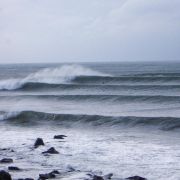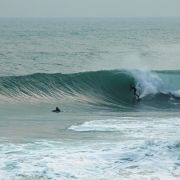How to predict what the surf will be doing
Below are a list of some of the best indicators of when and where there surf will be over the next week or so. For live surf - check out our new 48 hour Cornwall surf report and don't forget the surfcam section
We are currently working on our own longer range surf forecast, so keep checking for progress. In the meantime we have cobbled together some tips on how you can figure it out yourselves.
How to Forecast Surf
For the following links to be any help you need to have a basic idea of how to predict or forecast surf. So what are we looking for and where to start?
Swell
Well the first thing we need is some swell. In simple terms swell is created by wind which is in turn created by areas of high or low pressure. For all intents and purposes we can forget high pressure systems and concentrate on the lows. It's pretty simple really the lower the low the bigger the swell.
Low pressures start at below 1000 millibars. Generally they go down to around 920 - this would create a huge swell and the pressure chart would be a mass of concentric lines (isobars) creating what we like to call an onion skin as is seen in the photo on the right. In real terms a low pressure of below 990 is going to kick up some swell.
The next thing to figure out is when the swell generated by the aforementioned low pressure is going to arrive. The easiest way to work this out is longer than you expect and then add a day or two for good measure! To be more scientific it depends on how fast the wave travels across the open ocean. As a rule wave speed is around 20 Knots or just over 20mph, so it takes a while - you can do the math!
On a slightly more complex note there is another factor and that is the direction of the isobars. Baring in mind tha int low pressure the winds rotate anti-clockwise you can figure out the rough wind direction from the chart. This also helps us work out the swell direction. Another isobar related factor is how close together they are - the closer the windier. Also the length of a group of isobars poniting in one particular direction is going to mean bigger waves emanating from there.
Wind
You can try and work out the wind direction yourself from the pressure chart but it's probably easier to get this information from the weather. What you are looking for is offshore, preferably light or no wind at all. The offshore wind tends to prevent the wave from breaking as soon and gives it extra power when it does, it also helps smooth any chop off the face of the wave
Choosing a spot
Ok, so you know what the wind is doing and you know how much swell there is. Where to go? Well, probably the easiest thing to do is look at one of the webcams. The alternative is to work it out for yourself.
First how much swell is there? If it's tiny then you need to go to one of the more exposed beaches such as Perranporth regardless of the wind. If there is a bit of swell and the wind is Westerly you're pretty stuffed as well, it's onshore nearly everywhere.
When the swell is big is where you have some choices. Then it's a matter of checking the wind and finding a spot that is offshore. There is also the issue of whether the spot can hold a big swell or whether you want to surf 12ft close outs by yourself!
The final factor to consider is the state of tide. Most places are slightly bigger on an incoming (pushing) tide. Plus most places tend to 'fill up' at high tide and become 'bouncy' and 'fat'. At low tide waves are often hollower but also tend to close out.
Glossary of terms
Wave Height - The vertical distance from the wave trough to the wave crest.
Wave Period - The time interval for successive crests or troughs to pass a fixed point. (To measure the wave period start a stop watch when a crest of a wave passes under your kayak, then stop it on the next crest, Do this several times to get an average.
Wave Length - The distance between successive peaks or troughs.
Wave Celerity - The speed that a wave moves through the water.
Wave Spectrum - Wave spectrums are when all the wave periods are taken into account (the periods of interest are from about 2 seconds to 25 seconds.)
Wind Swell - Those waves that are being generated by the wind acting on the water surface at that time. They tend to have a short wave period (less than 8 seconds)
Swell Waves - Those that have moved away from the wave generating area. They tend to have periods of 10 seconds or more and travel away from the storm in a similar manner to ripples formed by dropping a stone into a pond, except in only one direction. (The same direction as the wind)
Duration - The time that the wind has been blowing over the surface from a single direction.
Fetch - The length of the wind field in one particular direction.
Deep Water Wave - Waves that are in water deeper than 1.5 times their wavelength, i.e. those out to sea
Shallow Water Wave - Any wave in water less than 1.5 times its deep water wave length. (A shallow water wave is said to have felt the bottom)







